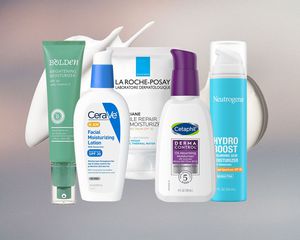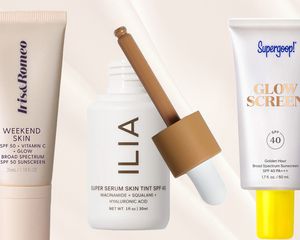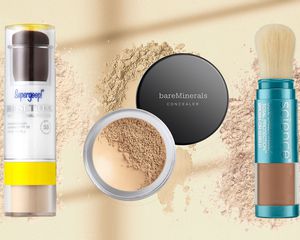:max_bytes(150000):strip_icc()/Stocksy_txp2752e2b9Gtg300_Medium_4067392-3d844018a599483992a8427fcd563be4.jpg)
Stocksy
If you're using sunscreen every morning, there's a good chance that you're using the ingredient homosalate daily, without even knowing it. Sunscreens fall into two camps: physical formulas (which rely on minerals such as zinc oxide and titanium dioxide to sit on top of the skin and deflect rays) and chemical formulas (which rely on chemical ingredients that penetrate the skin and absorb UV rays before they can cause damage). Homosalate is the main active in the latter, found in an array of chemical sunscreens.
Ahead, dermatologist Eddie Fincher, cosmetic chemist David Petrillo, and board-certified cosmetic dermatologist Shereene Idriss weigh in on everything you need to know about homosalate—including the controversy surrounding it.
Homosalate
Type of Ingredient: Chemical sunscreen
Main Benefits: Absorbs UV rays, specifically UVB rays, to ward off damage to the skin cells' DNA known to cause cancer, says Fincher.
Who Should Use It: Everyone should use sunscreen daily; however, those with sensitive skin may prefer to opt for mineral-based sunscreens.
How Often Can You Use It: If you're using a sunscreen with homosalate, it can, and should, be used daily and even reapplied every two hours for maximum protection.
Works Well With: It's always paired with other chemical sunscreens such as avobenzone, octinoxate, and octisalate to ensure complete, broad-spectrum UV coverage.
Don't Use With: There aren't any specific ingredients known to interact poorly with homosalate, but it (and other chemical sunscreens) can cause skin irritation for some.
What Is Homosalate?
"Homosalate is an organic compound belonging to a class of chemicals known as salicylates," explains Petrillo. It's a chemical sunscreen that shields the skin from sun exposure by absorbing UV light and converting it to heat so that it can't cause DNA damage to the skin cells, he adds. There are plenty of other chemical sunscreen ingredients, but homosalate is incredibly common. In fact, it's found in almost half of commercially-available sunscreens, notes Fincher.
The Benefits
According to Petrillo, there isn't a huge difference between the various chemical sunscreen ingredients, all of which work the same way. The differences lay in terms of which specific UV rays they can absorb and protect against.
- UVB-blocker: Homosalate, in particular, is a UVB-blocker, protecting against the UV damage that is known to cause skin cancer, says Fincher. To that point, "since it has very limited efficacy against UVA rays, it needs to be combined with other agents to ensure complete protection in broad-spectrum," adds Idriss. (She also notes that homosalate isn't particularly photostable and needs to be combined with other ingredients to keep it stable as well.)
- Broad-spectrum sunscreen ingredient: It's this combination of chemical sunscreen ingredients, some of which work against UVA rays and some of which work against UVB rays, that will offer a larger range of protection so that a sunscreen can be called "broad-spectrum," notes Fincher.
Meet the Expert
- Eddie Fincher is a dermatologist of Moy Fincher Chipps Facial Plastics and Dermatology.
- David Petrillo is a cosmetic chemist and the founder of Perfect Image.
- Shereene Idriss is a board-certified cosmetic dermatologist.
Potential Side Effects
Skin irritations and/or allergic reactions to homosalate are the biggest side effect, says Fincher (the same goes for pretty much any chemical sunscreen ingredient). If you experience redness or irritation, switch to a mineral formula instead.
Is Homosalate Safe?
Chemical sunscreens such as homosalate have been criticized online due to recent formula recalls, however, dermatologists agree that chemical sunscreens are widely safe. (And that the risks of getting cancer from skipping sunscreen far outweigh the risk of using a chemical sunscreen.) "We know for certain that these chemical ingredients are effective in preventing DNA damage and skin cancer, and there are no known adverse effects on humans," says Fincher.
Homosalate's mechanism of action—and that of any chemical sunscreen—depends on it being absorbed into the skin (unlike physical sunscreens, which sit on top of the skin). It's this absorption into the body that's incited talk about the safety of these ingredients.Y
You've likely seen buzzy headlines that link sunscreen usage to cancer, but according to the experts we spoke with, it's not quite that simple (or scary). The FDA is currently investigating homosalate and other active chemical sunscreen ingredients. Studies have shown that most of these chemicals are absorbed through the skin and can be detected in the blood, explains Fincher. However, he underscores that there aren't any studies in humans that have shown any adverse effects from this absorption.
The bottom line is this: If you're still concerned about using chemical sunscreens like homosalate, use a mineral formula. Whatever you do, don't ever skip SPF.
How to Use It
LIke any other sunscreen in your routine, a homosalate-based SPF should be applied as the last step in your morning skincare routine, should feature broad-spectrum protection of SPF 30 or higher, and should be reapplied every two hours (or immediately after heavy sweating or swimming). And to get the SPF level listed on the bottle, keep in mind that you need to apply 1/4 teaspoon of the formula to your face and neck. (A derm's trick is that for most people, 1/4 teaspoon is typically the length of your index and middle finger.)
The Takeaway
Homosalate is a type of chemical sunscreen that works by absorbing the sun's rays. And while there has been a lot of criticism and fear-mongering surrounding chemical sunscreens, dermatologists agree that chemical filters such as homosalate are safe to use, and skipping sunscreen altogether is far more dangerous. However, if chemical sunscreens still make you feel uneasy, you can opt for a mineral formula featuring zinc oxide or titanium dioxide as the active ingredient, instead.



